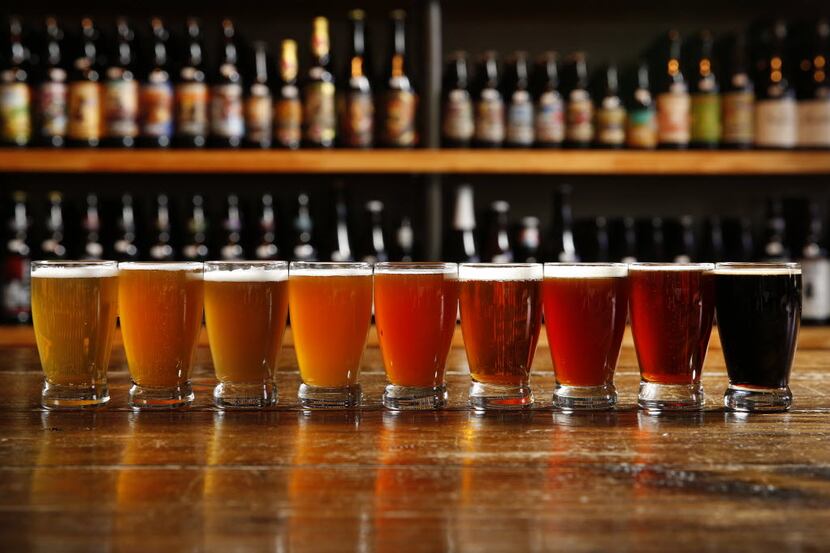It's hard to ignore the craft beer explosion over the last several years in Dallas-Fort Worth. Stores that once carried standard beer selections now stock an interesting range of styles and flavors -- things that many people didn't realize existed just a few years ago.
Many bars and restaurants serve a strong selection of local craft beers, and craft has taken over retail shelves, too. Some grocers such as Whole Foods Market and Central Market have even built bars with special tappings, growler fills and food pairings.
As an early participant in this phenomenon, I've found it fun to be surrounded by people so passionate about beer. Even more exciting are the large numbers of transitional beer drinkers just starting their craft beer journeys.
Ultimately, there are two possible paths for such an expedition: You can head out into the unknown and see where it leads, or you can arm yourself with a map and decide which way you want to go. Frankly, the best approach is a combination of both.
But what's a journey without a guide? This is where we come in.
This is a beginner's guide to beer styles. It's generally organized by color, from lightest to darkest, but know that beers don't always fit in a linear progression. As connoisseurs may notice, for every beer this guide describes, there are as many left out. It's nearly impossible to cover the ever-expanding craft beer universe in a brief couple of paragraphs; that's part of the beauty of this strange little trip we're on.
Whatever path you take, just make sure to take it. Some roads may lead to dead ends, but others may lead to beers you'll love. And just like momma always said, don't judge something before you try it.
Blonde ale

Often a great starter beer for future craft beer lovers, these beers are light- to medium-bodied and typically pale or straw in color. They are malt balanced, with low to medium hop flavor and aroma. High drinkability makes this a very approachable style, and it's traditionally lower in alcohol content, around 4 percent to 5 percent.
American wheat/Belgian wit

Traditionally brewed with significant amounts of wheat (instead of barley), these are lighter colored and cloudy, as they're typically unfiltered. This lends a smooth, creamy mouthfeel. They may be brewed with things like orange peel and coriander. These crisp, refreshing styles are generally low in hops and alcohol by volume (roughly 4 percent to 5.5 percent).
Belgian ale

Belgian ales are defined by the yeast used for fermentation, which provides the telltale Belgian profile. Colors and strengths vary, but the common denominator is the expressive yeast that lends fruity and spicy flavors and aromas. They typically have lower bitterness and are fairly dry because of their sugar, which boosts ABV without residual maltiness.
American pale ale

This is a popular American craft category. These are light- to medium-bodied, relatively low to medium ABV (4 percent to 6 percent) and often easy-drinking, with a slight citrus or earthy bitterness coming from the hops. Another great starter craft beer style.
Amber/red ale

Slightly darker in color, ranging from dark copper to deep red, this styles is malty, medium-bodied style with hints of toast, bread and light fruit. It has low to medium levels of hops and low- to mid-range alcohol content, around 4 percent to 7 percent.
India pale ale (IPA)

Hops are the star in American craft's most popular style. They dominate flavor and aroma, ranging from citrus, pineapple, blueberry and pine needle to earthy, spicy and bitter. The style is medium-bodied, pale to amber in color and about 6 percent to 8 percent ABV.
Barleywine

These ales get the misleading name because of higher levels of alcohol, which may approach wine strength. They're generally amber to dark brown in color and have malty sweet, fruity flavor profiles, particularly plum, apricot or fig, with perceived notes of alcohol. ABV ranges from 8 percent to 12 percent.
Porter/stout

Though these are traditionally separate beer styles, America's craft movement has blurred some of the differentiating lines. These are dark, malt-forward brews with tasting notes of coffee, chocolate and burnt toast. The main difference between the two is that stouts typically have more roasted or smoky malt aroma than porters. Barrel aging these beers has become popular. Hop levels are usually low but can vary depending on the beer. ABV can range from low (near 4.5 percent) to imperial (upward of 14 percent).
American wild/sour ale

These styles are fairly new to American craft beer, but they've been brewed for a long time in places such as Germany and Belgium. The color can range from very light to dark brown or even black, depending on the malts used. They're created by adding wild yeast and souring bacteria, which dry out the beer and create funky, tart, sometimes mouth-puckering flavors.
Booze News Insider Kevin Carr is the founder of Community Beer Co., an award-winning brewery located in Dallas, Texas.

